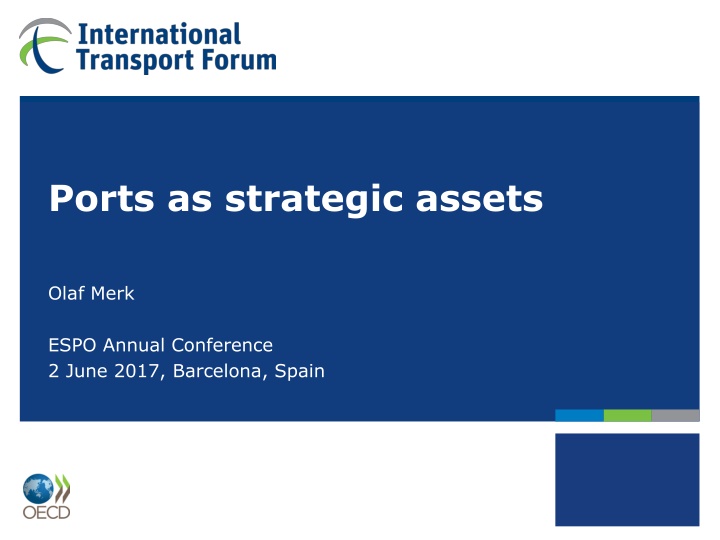Ports as Strategic Assets: Leveraging Geopolitical and Climate Change Opportunities
Ports play a crucial role in shaping a stronger, greener, fairer, and smarter Europe. They serve as catalysts for climate change mitigation, offer strategic geopolitical advantages, and drive innovation in a dynamic global-local context. Port incentives targeting climate change include lower dues for reduced ship speeds and carbon emission criteria for concessions. Moreover, ports can influence supply chains, provide services to naval vessels, and impact geopolitical dynamics. The evolving landscape of Chinese participation in EU ports adds complexity to the geopolitics of the maritime sector.
Download Presentation

Please find below an Image/Link to download the presentation.
The content on the website is provided AS IS for your information and personal use only. It may not be sold, licensed, or shared on other websites without obtaining consent from the author.If you encounter any issues during the download, it is possible that the publisher has removed the file from their server.
You are allowed to download the files provided on this website for personal or commercial use, subject to the condition that they are used lawfully. All files are the property of their respective owners.
The content on the website is provided AS IS for your information and personal use only. It may not be sold, licensed, or shared on other websites without obtaining consent from the author.
E N D
Presentation Transcript
Ports as strategic assets Olaf Merk ESPO Annual Conference 2 June 2017, Barcelona, Spain
2 Ports are strategic assets for a stronger, greener, fairer, smarter Europe A powerful geopolitical tool Catalyst for climate change mitigation Generator of employment and social cohesion A testing bed for innovation Within a dynamic global-local interaction
3 Ports as catalysts for climate mitigation Could ports be the tail that wags the dog?
4 Strategic climate change incentives by ports Three levers: dues, concessions, berth allocation Port dues: Lower port dues if ship reduced speed in territorial waters (Long Beach) Not only local pollutants, also carbon (Sweden): adapt criteria ESI, GreenAward Not only bonus, also malus. So more coordination between ports needed Port concessions and procurement: Carbon emissions as one of criteria for port concessions (terminals, towage). Related: carbon targets for EU funding of port infrastructure Berth allocation: Clean ship jumps queue (Panama) Put such incentives in IMO 2018 Initial GHG Strategy
5 Ports as a strategic geopolitical tool to prioritise own and strategic supply chains (preferential berthing) block supply chains of foreign nations (via port closures or more subtle measures) provide services to naval vessels (provisioning, bunkering, ship repair) Becoming increasingly relevant in current context ( We are on our own now Angela Merkel)
6 Ports and geopolitics: current state Growing divergence of Chinese participation in EU ports and EU participation in Chinese ports Emerging ambition of Chinese state-owned companies in foreign terminal operations. Asymmetry in allowed foreign ownership shares Privatisation of port authority functions Increased inter-relation of carriers and terminals (and terminal joint ventures) obfuscating matters
7 Growing divergence Chinese terminal stakes in Europe European terminal stakes in China 30 30 25 25 20 20 15 15 10 10 5 5 0 0 2003 2016 2003 2016 Private China State-owned China Private EU State-owned EU Chinese state-owned capacity in EU: 8.6 mln TEU Source: ITF/OECD elaborations based on Drewry
8 Asymmetry foreign ownership shares Chinese terminal stakes in Europe European terminal stakes in China 100% 100% 90% 90% 80% 80% 70% 70% 60% 60% 50% 50% 40% 40% 30% 30% 20% 20% 10% 10% 0% 0% 0 1 2 3 4 5 6 0 2 4 6 8 Terminal capacity (mln TEUs) Terminal capacity (mln TEUs) No European majority stakes in Chinese ports Source: ITF/OECD elaborations based on Drewry
9 Vertical integration (carriers-terminals) 100% 90% 80% 70% 60% Other 50% GTOs Carriers 40% 30% 20% 10% 0% 2001 2002 2003 2004 2005 2006 2007 2008 2009 2010 2011 2012 2013 2014 2015 Carrier-owned terminals have 38% market share of terminal capacity Source: ITF/OECD elaborations based on Drewry
10 Horizontal integration 80 70 Market share container lines (%) 60 50 40 30 20 10 0 2000 2001 2002 2003 2004 2005 2006 2007 2008 2009 2010 2011 2012 2013 2014 2015 2016 Top 4 Top 10 Top 4 carriers have 50% market share of container ship capacity Source: ITF/OECD elaborations based on data from Alphaliner
11 Links between carriers and terminals Will carrier consolidation lead to trend of ports replacing multi-user terminals with carrier- driven terminals because they bring cargo ? So an easy target for quickly expanding carrier-driven terminal operators? Acquisition of even a small share in a carrier could give a foreign state a majority share in the terminals owned by the carrier E.g. CMA CGM and Terminal Link
12 How to be more strategic? Reciprocity in market access to port operations? Are ports less strategic than airline sector? They have maximum 49% foreign ownership. A list of strategic regulatory port functions that should not be privatised? Towards a network of global ports essential to EU supply chains or naval interests? Network formed by the foreign stakes of EU public ports
Thank you! Olaf Merk olaf.merk@oecd.org Twitter: @o_merk























